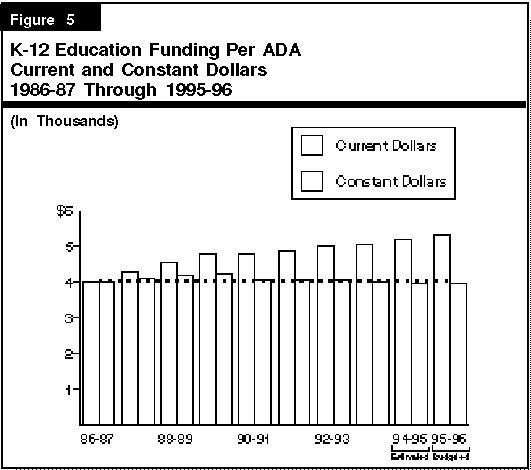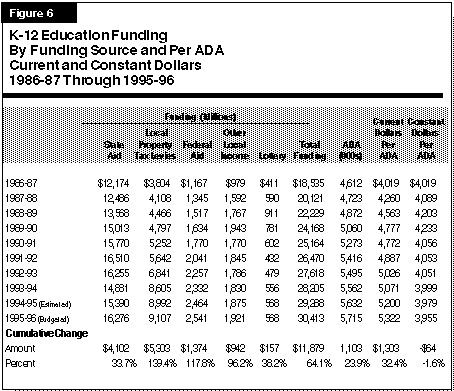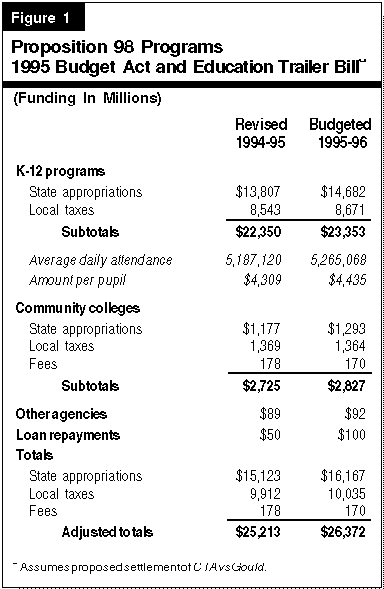
 Legislative
Analyst's Office, September 1995
Legislative
Analyst's Office, September 1995
This chapter provides a description of the major features of the 1995-96 budget plan. It includes individual discussions of the budget actions within each of the major program areas, as well as discussions of the budget actions that affect revenues.
In this section, we describe the major features of the budget package as they relate to the Proposition 98 minimum funding guarantee and K-12 schools. Most of the package's education provisions are contained in the education trailer bill--Ch 308 95 (AB 825, W. Brown).
Proposition 98 provides K-12 schools and community colleges a guaranteed minimum level of funding. The Proposition 98 portion of the budget package:
Proposition 98 Funding. The budget provides $26.2 billion ($16.1 billion General Fund) in Proposition 98 funding for K-14 programs in 1995-96. This exceeds the amount provided in 1994-95 by $1.1 billion ($925 million General Fund, $125 million local property taxes). This amount is the minimum needed to fully fund the Proposition 98 funding guarantee in 1995-96.
Figure 1 summarizes for 1994-95 and 1995-96 the effect of the budget package on the three major recipients of Proposition 98-- schools, community colleges, and other agencies. As the figure shows, the funding level for K-12 schools is $4,309 per pupil for 1994-95, which is $92 per pupil more than was provided in the 1994 Budget Act. These additional funds resulted from an increase in the Proposition 98 funding guarantee due to higher-than-projected General Fund revenues during 1994-95.

The 1995 Budget sets average per-pupil funding for 1995-96 at $4,435, or $126 above the adjusted per-pupil funding level provided in 1994-95.
As Figure 1 also displays, community college funding in 1995-96 increases by $103 million from the adjusted level provided in 1994-95. We discuss the community college's budget in the higher education section of this report.
CTA v. Gould. The amounts contained in Figure 1 for 1995-96 include $360 million that will not be immediately available to school districts. This is because these funds are appropriated contingent upon settlement of the CTA v. Gould lawsuit, which contests the legality of $1.8 billion in Proposition 98 loans made in the 1992 and 1993 Budget Acts. A tentative settlement of the lawsuit was developed during budget discussions. If the lawsuit is settled, the $360 million will be distributed to schools in August 1996.
Under the proposed settlement:
General Purpose Funding. The budget provides a total of $17.7 billion ($9.2 billion General Fund) for general purpose funding to school districts and county offices of education in 1995-96. This represents an increase of $157 per pupil from the amount provided in 1994-95. Figure 2 displays the major actions that result in the 1995-96 increase. As the figure illustrates, in addition to providing a 2.7 percent COLA, general purpose funding is increased for all districts by an average of $33 per pupil (0.9 percent). The budget also includes an equalization payment for "low wealth" districts which will narrow the differences in per-pupil funding among school districts.
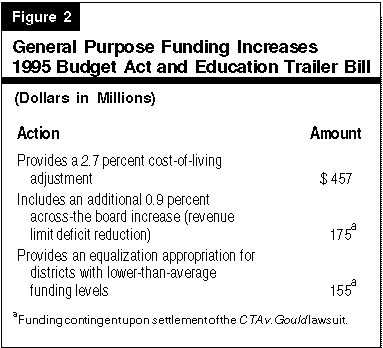
Categorical Programs. The 1995 Budget Act also increases funding for K-12 categorical programs by more than $360 million (see Figure 3.) The largest amount ($160 million) was provided for growth and COLA funding for certain categorical programs that are not part of the categorical mega-item (such as child development and adult education). An additional $136 million was provided in the form of a categorical block grant, $26 million set aside for a new state assessment program, $20 million for expansion of the state preschool program, and $20 million for expansion of the Healthy Start Program.
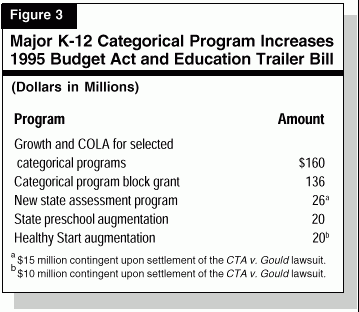
The categorical block grant generally provides growth and COLA funding to programs that are supported through the categorical mega-item. The growth and COLA funds, however, are not appropriated to specific programs. Instead, the funds are provided as a block grant that will permit school districts flexibility to allocate the additional funds to programs funded through the mega-item. The funds are distributed in an equal amount per ADA, rather than in proportion to the amount of categorical funds each district receives.
1994-95 Funding Increases. As discussed above, funding for schools in 1994-95 increased by $92 per pupil due to increased General Fund revenues as part of the education trailer legislation. The most important of these actions was the creation of a $280 million block grant that provides K-12 districts $50 per pupil for any one-time purpose. An additional $60 million was appropriated for deferred maintenance, instructional materials, and education technology.
In 1995-96, funding available for expenditure on K-12 education from all sources--including both Proposition 98 and non-Proposition 98 funding--will total $30.4 billion (see Figure 4). This amount represents an increase of $1.1 billion, or 3.8 percent, over what was available in 1994-95. Of the $30.4 billion in total funding, 90 percent is from state and local sources--77 percent provided under Proposition 98 and 13 percent from non-Proposition 98 sources. Non-Proposition 98 funding from state and local sources includes primarily (1) state General Fund payments to the State Teachers' Retirement System and for debt service on school construction bonds and (2) local revenues from such sources as developer fees, sales of equipment and supplies, cafeteria revenues, and interest income.
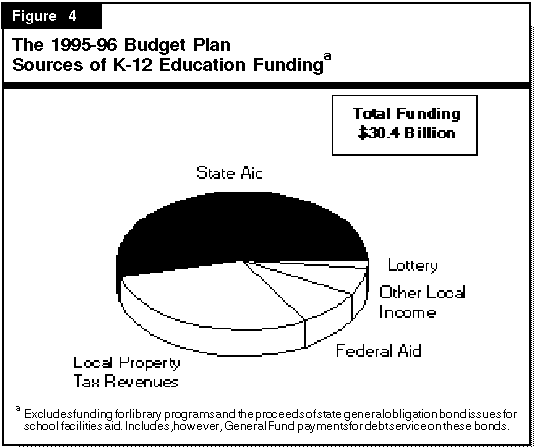
Other major sources of funding are:
Figures 5 and 6 show total K-12 funding per unit of average daily attendance (ADA)--in both current and "constant" (inflation-adjusted) dollars--for the years 1986-87 through 1995-96. They show that per-ADA funding in inflation-adjusted dollars has basically held steady, decreasing 1.6 percent during the ten-year period. While the budget significantly increases funding per student, Figure 6 shows that, after adjusting for inflation, per-ADA funding from all sources has continued to decline.
